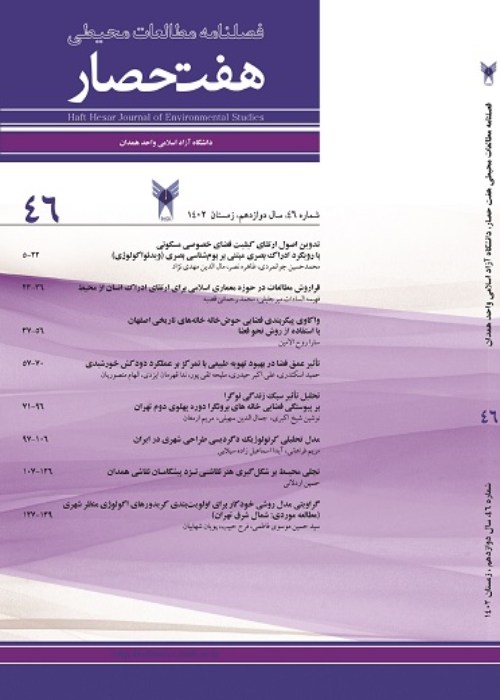Explanation of physical factors affecting spatial behavior in traditional city houses in Meybod
As the behavioral base of the family, the house is functionally and physically the place where the behavior, culture, and ethics of the community are formed. The traditional house of Iran has been a constructive and suitable place for this important. However, todaychr('39')s Iranian housing architecture is not a suitable container for this important because it has lost its Iranian character and has been deprived of the ability to cultivate Iranian culture. These changes have taken place both in the spatial organization of the house and in the way of life of the family. On the other hand, modernity and its processes have greatly affected the quality of modern and contemporary human housing, which may make todaychr('39')s houses more than half a century ago. Iran cannot be called Iranian houses. Therefore, patterns of space organization and its configuration should be examined to understand the relationship between the design of built spaces and the subsequent cultural dimensions.
The research method is grounded theory method, through interviews with experts, elements, and concepts affecting the spatial behavior of traditional houses with open, axial and selective coding. It shows that various factors in the physical dimension of spatial behavior in The formation of traditional houses in Meybod city play a role. However, human relationship with the environment has the most significant impact on perceptions of the environment. Then, to evaluate the effect of each of the variables, a questionnaire was developed and provided to the residents and the correlation results were calculated with SPSS software.
Perceptions of the environment are less correlated with other factors. Other factors that have the minor correlation include social tendencies, social strata, and selective activities. More with other factors; other factors that are more correlated include culture, ongoing activities, and adjustment.
conditions have caused the spatial organization of modern houses to be in different forms and types. This diversity is seen in the different patterns of modern homes centered on different "spatial behaviors." The causal conditions mentioned can become a significant category of the model, "becoming a pattern of spatial behavior." Obstacles to the development of todaychr('39')s residential homes can have consequences such as forgetting aspects of the traditional culture of building traditional houses in the country and the disappearance of the diversity of spatial behaviors. Obstacles can be managed by planning, proper management, and providing appropriate solutions such as advertising, unification of spatial and physical components of modern buildings, organizing behavioral contexts, organizing natural elements of the environment, and recognizing socio-cultural layers.
- حق عضویت دریافتی صرف حمایت از نشریات عضو و نگهداری، تکمیل و توسعه مگیران میشود.
- پرداخت حق اشتراک و دانلود مقالات اجازه بازنشر آن در سایر رسانههای چاپی و دیجیتال را به کاربر نمیدهد.


